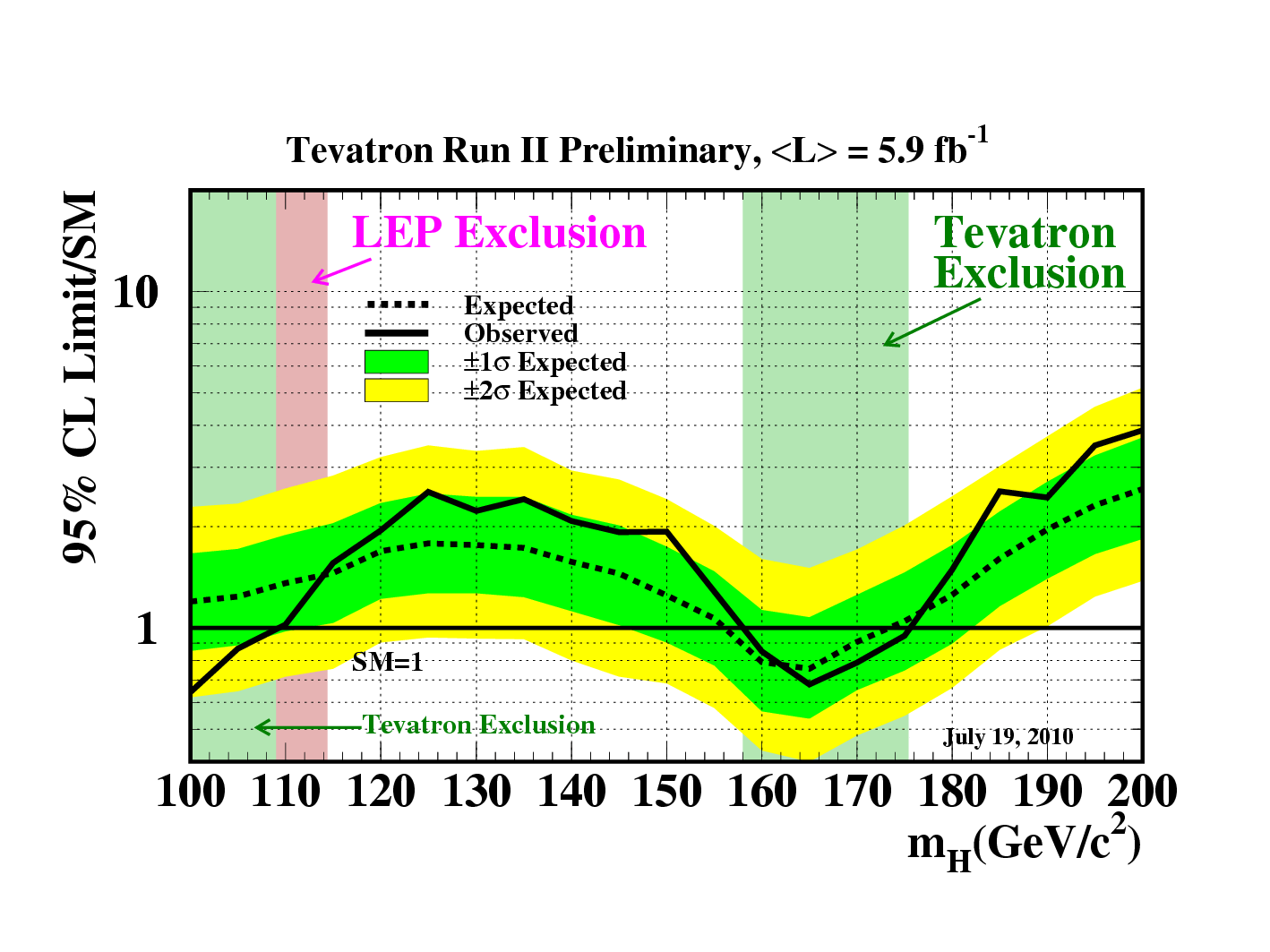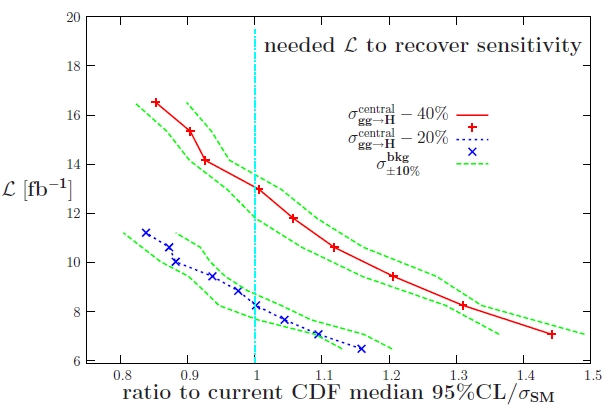The authors (J. Baglio, A. Djouadi, S. Ferrag, R.M. Godbole) move a direct attack to the results produced by the CDF and DZERO experiments on the search for the Standard Model Higgs boson, claiming that they are basically wrong; that is: they do not explicitly say so, but on the other hand they strongly argue that the limits were obtained with what are denounced to be less-than conservative assumptions about theoretical uncertainties in the predicted Higgs and background rates.
It is not the first time that somebody wages war to the Tevatron Higgs search results, and I can well understand the motives. However, while the other notable attempt I know of was rather clumsy and bordering the ridicule, this one appears more serious and well-founded. Let us see what it is about.
The heart of the matter is the prediction for the signal and background cross sections, and what uncertainty must be associated to them. The Tevatron analyses manage to exclude at 95% confidence level the region between 158 and 175 GeV, as shown in the plot below, mainly using searches for direct Higgs production and decay into pairs of W bosons.
 This figure has appeared in this blog already a couple of times, so I will comment it only briefly here. The y axis shows the limit in Higgs production rate in units of the expected SM rate, so that a limit below 1 means that the SM Higgs cannot have the corresponding mass (mass is on the horizontal axis). The black curve shows the CDF and DZERO combined limit, and this may be compared with the hatched line which shows what the experiments were expecting to obtain with the available data and analysis methods. So far all is good: the black line goes below 1.0 in the region 158-175 GeV, and there you have your limit.
This figure has appeared in this blog already a couple of times, so I will comment it only briefly here. The y axis shows the limit in Higgs production rate in units of the expected SM rate, so that a limit below 1 means that the SM Higgs cannot have the corresponding mass (mass is on the horizontal axis). The black curve shows the CDF and DZERO combined limit, and this may be compared with the hatched line which shows what the experiments were expecting to obtain with the available data and analysis methods. So far all is good: the black line goes below 1.0 in the region 158-175 GeV, and there you have your limit.In the region where a mass limit is indeed obtained at the Tevatron, the searched process is direct production. Direct Higgs production occurs primarily through a virtual loop of top quarks, is crated by initial state gluons. This is not the simplest Feynman diagram you could draw, and indeed the theoretical estimate of the process is not very precise, as can be gauged by the fact that including higher-order diagrams in the calculation produces significant variations. From these so-called "NLO/LO ratios" (also known as "k-factors"), the experiments infer the uncertainty on the theoretical cross section. Furthermore, parton distribution functions of the initial state bodies which produce the Higgs also bring significant uncertainties into the calculation.
In their studies, the Tevatron experiments assume uncertainties in the signal cross section amounting to 20%. This is criticized by the authors of the paper, who claim that larger uncertainties should be used. If a larger uncertainty is (as they argue, more motivated) is chosen, then the Tevatron upper limit on the Higgs cross section worsens considerably.
Another criticism concerns the (bad, but universal) practice of adding uncertainties in quadrature. I will not discuss this point here, since it is quite hard to do otherwise in most experimental situations. Here authors may have a point but it is objectively hard to criticize the Tevatron experiments for this choice.
Further, the authors also question whether the main SM background, direct WW production, has a cross section equal to what the experiments assume in their analyses; a larger background cross section would decrease the power of the searches. They have tried to recompute the CDF and DZERO limits on the Higgs cross section for the case of Higgs mass of 160 geV, one of the mass points best excluded by the experiments, by using different assumed signal cross sections and background level. The slightly surprising result is that a "worst-case scenario" where the central theoretical estimate of SM rate is lowered by 20% would produce no limits on the Higgs mass. Even worse, nightmare scenarios, are discussed.
The article is only four pages long, and it is simple and easy to read, so it makes little sense for me to summarize it here further. I will just paste below the main result, which is a figure showing on the vertical axis the integrated luminosity that the experiments should need to analyze in order to recover the same sensitivity to the Higgs (at 160 GeV) which thy claim to have with 5.9 inverse femtobarns of analyzed data.

The figure has on the horizontal axis the ratio between the limit that could be and SM cross section, so that the vertical line at 1.0 is where the Higgs can be excluded at 95% confidence level. If the conservative approach of the authors is chosen, one should conclude that the Tevatron would need a much larger luminosity to obtain the results they have published already. Also note that according to the authors, changing the background level (all backgrounds!) by 10% (green lines) would significantly change the picture.
My opinion
My opinion on the criticism moved to the Tevatron analyses by the authors of this study is that although the points raised make sense, they are largely arguable, and arbitrary. In other words, there is no real reason to take such an extremely conservative point of view when deriving a limit on a searched process as to tax oneselves by assuming that the searched process rate is lying at the lower limit of the predicted range.
Also, I do not concur with the authors on the estimate of backgrounds and the artificial increase of all backgrounds by 10% (the uncertainty of the WW component). In many of the search bins of the high-mass search backgrounds include, contrarily to what authors claim, lager components than WW production; for instance, in the 1-jet bin (one of the subsamples used in the analysis), the Drell-Yan background is the largest component.
In any case, it should be mentioned that the method by which CDF and DZERO obtained their limits is public: their paper is online and anybody can draw their own conclusions - as indeed the authors have shown, this can be easily done.
Further, a minor note should be made on the fact that while the authors have taken as reference a Higgs mass of 160 GeV, they failed to take as reference the integrated luminosity corresponding to that mass point. Although the first plot shown above indeed reads "L=5.9/fb", that is a sensitivity-weighted average over the whole set of searches that the Tevatron experiments performed. At 160 GeV, however, only a subset of those searches matter: those for WW pairs. CDF and DZERO analyzed different sets of data for the different searches, and for the WW the integrated luminosities used are respectively 5.9 and 6.7 inverse femtobarns. This does not significantlychange the results of the paper, of course.
And finally, a maybe politically-incorrect comment. The authors thank in their acknowledgements a colleague who gave the seminar which was the subject of my less than enthusiastic criticism at the beginning of this piece. I hope they did not get too influenced by his views -it can't do much good to them.





Comments